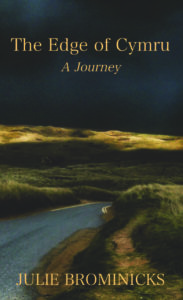Small spiders, large landladies and vandalised bus shelters: Julie Brominicks’ attentive ‘The Edge of Cymru’ is yet another example of excellence on a shoestring from Seren Books, writes Steven Lovatt.

In 2012 Julie Brominicks left her job as a teacher and ecologist in north Wales and began walking the perimeter of her adopted country. Already an experienced hiker, she sought to stretch herself as a writer while also learning more about Wales, in part to ease her feeling of guilt as an English incomer. Among other virtues, The Edge of Cymru documents the process by which this guilt was metabolised, through the intimate action of walking, into a sense of responsibility, love and tentative belonging.
Postcolonial criticism has exposed the degree to which the literary sub-genre of Welsh walking tours is compromised by a supercilious anglocentrism. Babies and bathwater need to be separated, and there’s a big difference between, say, the exoticizing but respectful doyen George Borrow and the open sneering of Paul Theroux. But the basic problem is glaring. The Edge of Cymru breaks and remakes this tradition, partly because Brominicks is a woman, more so because of her humility, and fundamentally because the context for nature writing has changed so utterly over the last half-century that any honest account is necessarily in schism with its inheritance. Brominicks is a knowledgeable and frank chronicler of environmental breakdown, and she writes always in the shadow of what we have done to the earth by our ‘small reluctances’ to eat less meat, cease flying or look out onto a windfarm.
But the book is also different because of its style and sensibility. The Edge of Cymru grows out of an aggregation of fleeting impressions of landscapes, buildings and people met with on Bromincks’ journey. The effect, although the book is written in the past tense, is that we walk with her in the brisk immediacy of the present continuous. Her loving attentiveness is indiscriminate, egalitarian and grounded: small spiders, large landladies and vandalised bus shelters ‘sparkling’ with broken beer bottles are all documented with the same curiosity and disarming sympathy. In a wider context, Brominicks’ immersion in this technique also makes unusually visible the tension underlying all nature writing, between the intransigently non-narrative quality of field-notes and the commercial demand for more processed prose — for books that discuss, explain and interpret. If The Edge of Cymru strikes the reader strangely, it may be because Brominicks’ abstinence from interpretation makes the accretion of facts and observations seem naked and unmediated. I did occasionally wish that a remark be expanded upon, notwithstanding that more digression and reflection would lessen the effect of the book’s distinctive pointillism.
There are a few, more objective, flaws that you’d expect to be caught before the reprint: the odd factual error (Swansea’s Dragon Hotel has been misplaced by half a mile) and typo, some obtrusive repetitions, and in the historical summaries, sources too thinly paraphrased. Brominicks has an odd way with commas, too, though you soon get used to it. The book’s subtitle ‘A Journey’ also feels a bit uninspired. Overall, though, The Edge of Cymru is yet another example of Seren Books producing excellence on a shoestring.
Structurally, the progression of chapters maps onto the counties that Brominicks walks, and each begins with a concise, contextualising summary of a relevant aspect of Welsh natural and social history. Much of the research was undertaken after the walk was completed, and references to later events such as the Covid-19 pandemic add depth and narrative texture. The book is very much concerned with time, and dizzying effects are achieved by juxtaposing geological time with human history from the Ice Age to our current epoch of hyper-capitalist anomie.
But The Edge of Cymru everywhere finds and inspires delight in the relationship between words and world. The gravity of its themes is balanced by understated humour, some situational and some discovered in sly word-play, as when a field of oats is seen to ‘quake’. Brominicks has a particular gift for sonorous verb phrases that defy you not to speak them aloud:
‘a shower smacked the wayside rosehips’
‘Sand softened the spits’
Rocks that are ‘blasted, stressed and inky’
There’s a shimmering lode of poetry in these descriptions, sometimes extruded in a line that recalls the strange beauty Les Murray’s verse:
‘Rough rock was red or egg-box grey and the top layers had worked loose and wobbled.’
Nobody else writes this beautifully in quite this way, and if there’s room for doubt whether Bromincks’ clipped style suits long-form nature writing then the onus is plainly on the latter to adapt and accommodate it.
My abiding impression of The Edge of Cymru is of a still snipped from an ongoing cine-reel of Welsh cultural and landscape history, a picture of sorrow for what is being lost and love for what yet remains. Or as Brominicks puts it with eloquent simplicity, ‘I was a witness of Cymru’s edge at a point in time, before it changed’.
*
‘The Edge of Cymru: A Journey’ is out now, published by Seren Books, and is available here (£12.34).
Steven Lovatt wrote ‘Birdsong in a Time of Silence’ and edited ‘An Open Door: New Travel Writing for a Precarious Century’. He reviews for The Friday Poem and does freelance copyediting from his home in Swansea.